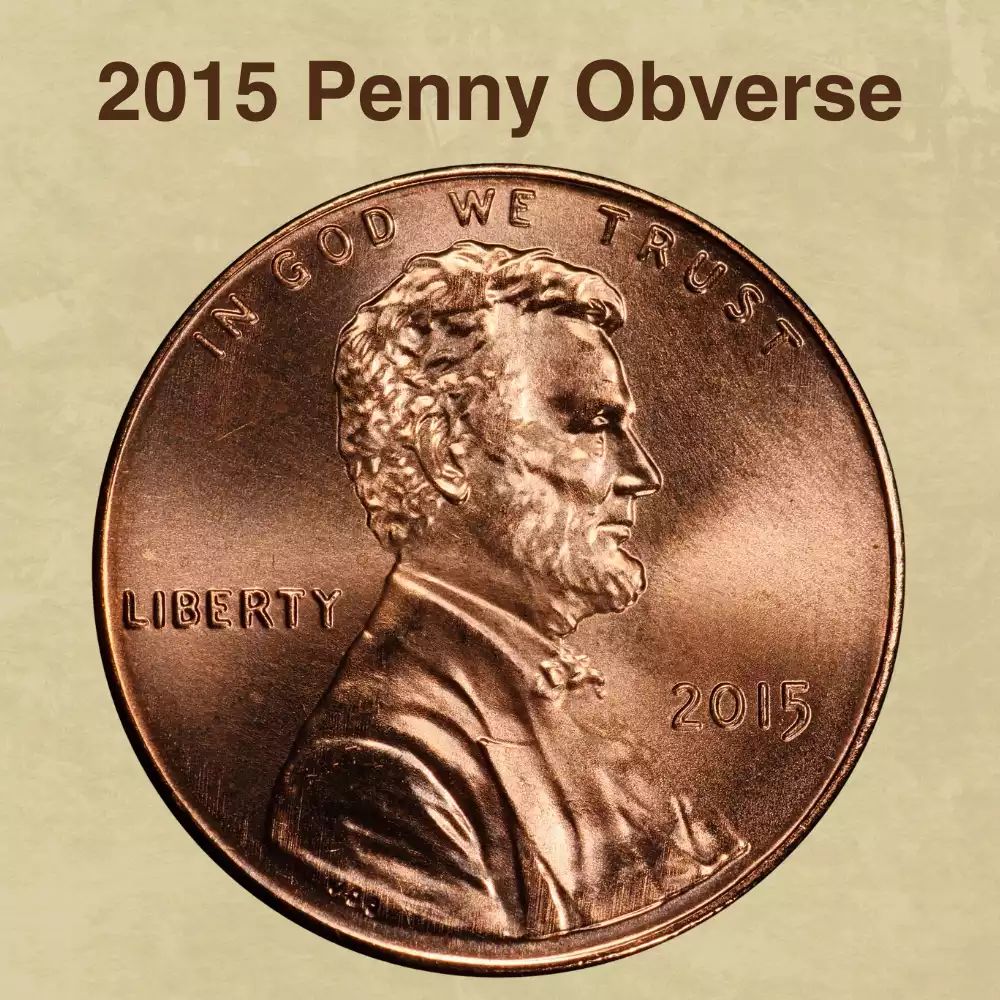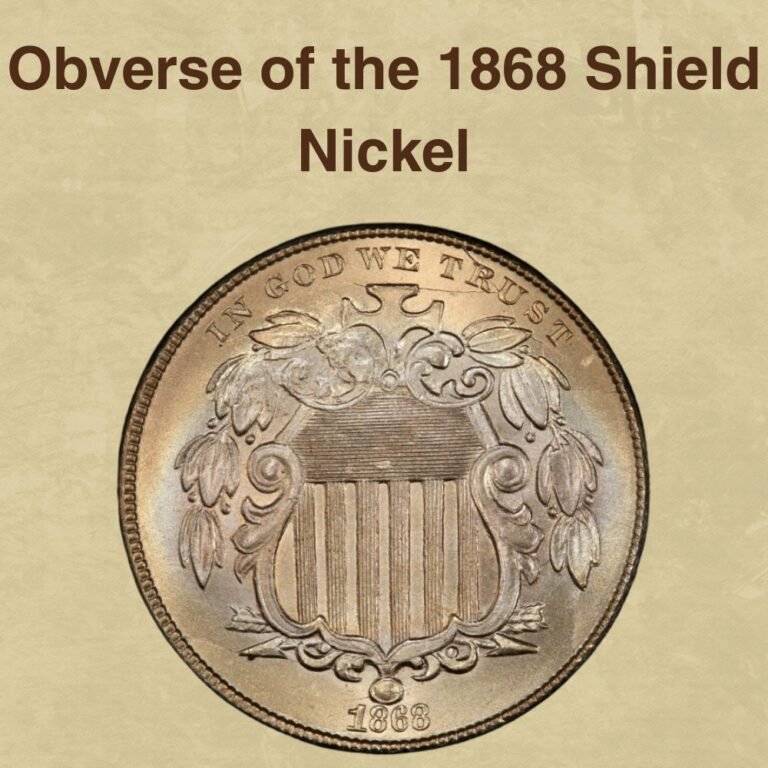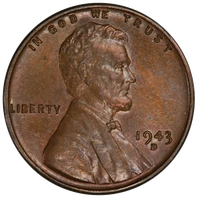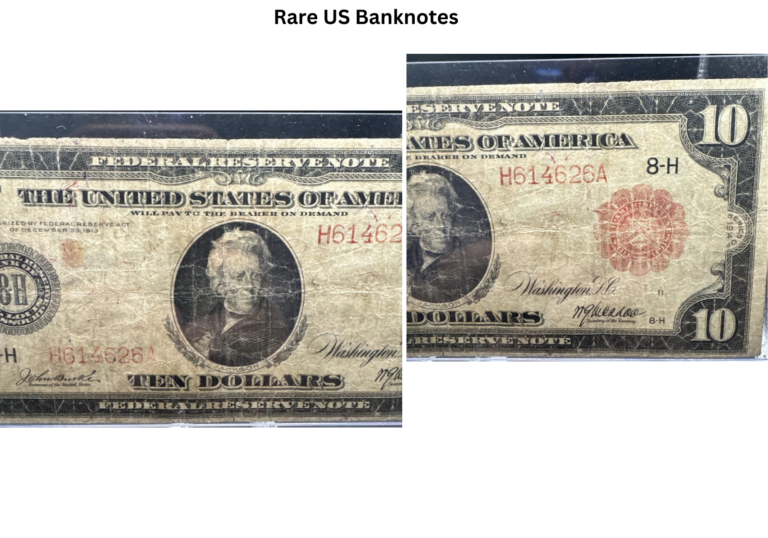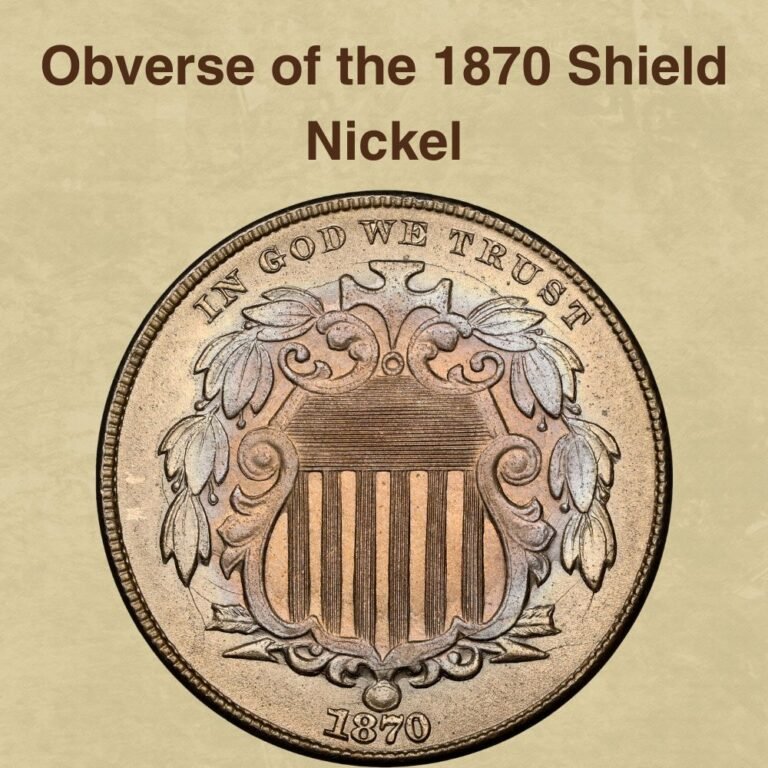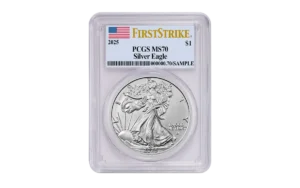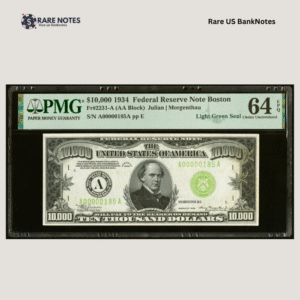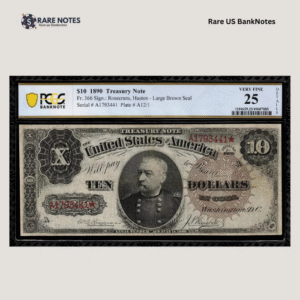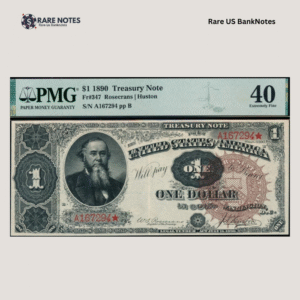While most 2015 pennies circulating in your pocket change are worth just their face value of one cent, savvy collectors know that finding pristine examples of these Lincoln Shield cents can be surprisingly challenging.
The Great Recession of 2008 had caused demand from institutional banks for new coinage to plummet, which meant that the Federal Reserve wasn’t distributing Shield Cents to the banks where customers (and collectors) could buy rolls and bags.
This distribution bottleneck affected the entire Shield cent series launched in 2010, making uncirculated 2015 pennies somewhat scarcer in everyday circulation than their massive mintage numbers might suggest.
Though over 9.3 billion 2015 pennies were produced between Philadelphia and Denver mints, collectors willing to hunt through bank rolls can still discover valuable uncirculated specimens worth 10 to 30 cents each, with exceptional high-grade examples commanding significantly more.
2015 Penny Value By Variety
The following chart shows current market values for 2015 pennies in different grades and mint varieties.
2015 Penny Value Chart
| TYPE | GOOD | FINE | AU | MS | PR |
|---|---|---|---|---|---|
| 2015 No Mint Mark Shield Penny Value (RD) | — | — | $1 | $89 | — |
| 2015 D Shield Penny Value (RD) | — | — | — | $53 | — |
| 2015 S DCAM Shield Penny Value | — | — | — | — | $9 |
Tip: Chart shows Red (RD) prices only. For Brown (BN) or Red-Brown (RB) values, check our CoinValueChecker App for comprehensive information across all color designations.
2015 Penny Market Trend
Market Interest Trend Chart – 2015 Penny
The collector interest pattern for 2015 pennies reveals a telling journey through the modern numismatic landscape. Initial enthusiasm following the coin’s release created a dramatic spike in market attention, as collectors rushed to acquire fresh examples of the Shield cent design.
However, like many modern issues, this excitement gradually settled into more sustainable levels as the novelty factor diminished and collectors realized the substantial mintage numbers.
What’s particularly noteworthy is how the trend stabilized rather than completely disappearing, suggesting that 2015 pennies have found their niche among dedicated collectors who appreciate the Shield design and hunt for high-grade specimens.
The periodic upticks in interest often coincide with discoveries of notable error varieties or when prominent dealers feature uncirculated rolls, reminding the market that even common-date coins can offer collecting opportunities.
This steady, if modest, collector interest has helped 2015 pennies maintain their position in the broader numismatic market.
For context on how this compares to other modern issues, the comprehensive US Coin Market Trend Ranking (Top 100) provides valuable perspective on where Shield cents stand relative to other contemporary collecting categories.
History of the 2015 Penny
The 2015 penny represents the mature phase of the Shield cent era, reflecting a period when this distinctive design had fully established its place in American coinage. Since its debut in 1909, the Lincoln cent has maintained an unbroken production streak, evolving through several design periods.
The year 2015 fell squarely within what collectors now call the “Shield cent era”—a period that began in 2010 after the special commemorative 2009 Lincoln Bicentennial series concluded.
Artist Lyndall Bass had won the competitive selection process through the US Mint’s Artistic Infusion Program, creating the shield design that would define Lincoln cents from 2010 onward, including the 2015 issue.
But 2015 holds a unique place in coinage history for reasons beyond design. The year represented a sweet spot in America’s economic recovery, where the lingering effects of the 2008 financial crisis created an unusual phenomenon in coin distribution.
While the mints churned out an impressive 9.3 billion pennies between Philadelphia and Denver—massive numbers by any standard—these coins didn’t flow into circulation the way they traditionally had.
Banks and businesses, still cautious about inventory costs, ordered fewer fresh coins than in pre-recession years. This created a paradox that delights modern collectors: a coin with enormous production numbers that somehow remained surprisingly difficult to find in pristine, uncirculated condition.
Also Read: 10 Most Historic Years of Modern Lincoln Penny (1959-Date)
Key Features of the 2015 Penny
The Lincoln pennies’ features, design, and composition have evolved significantly since their debut in 1909. For instance, the reverse design underwent four major transformations throughout the series. The Shield design era, which began in 2010, represents the newest chapter in this evolution, making coins minted in 2015 part of this contemporary period.
The Obverse of the 2015 Penny

The obverse side of the 2015 penny features Abraham Lincoln’s portrait as the central element. This profile has remained largely unchanged since 1909 when Victor David Brenner first created it.
Lincoln’s profile is positioned in the center of the coin’s obverse, facing right. Above his portrait, just below the rim, appears the motto IN GOD WE TRUST. The word LIBERTY is located along the left side of the field, aligned with Lincoln’s neck area.
The minting year 2015 is positioned on the lower right side of the coin, in front of Lincoln’s chest, while the mint mark appears below the date when present. Brenner’s initials, VDB, are located under Lincoln’s right shoulder, restored to this position in 1918 after their controversial removal in 1909.
The Reverse of the 2015 Penny
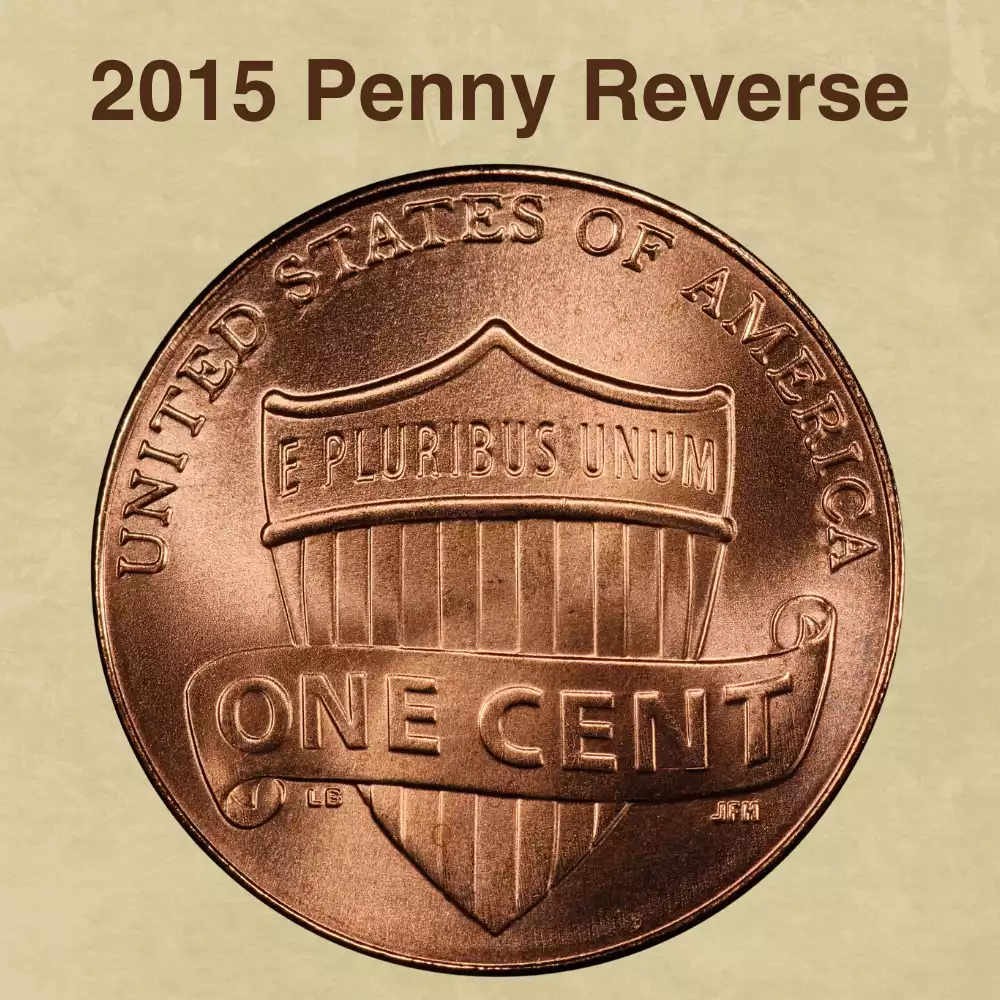
The reverse design of the 2015 Lincoln penny displays Lyndall Bass’s Union Shield creation that debuted in 2010, replacing Frank Gasparro’s Lincoln Memorial design that had served for nearly five decades. The central feature of this reverse side is a Civil War-era shield representing Lincoln’s preservation of the Union.
The shield displays thirteen vertical stripes representing the original states, unified under a horizontal bar symbolizing the federal government. The motto E PLURIBUS UNUM graces the top of the shield. The inscription UNITED STATES OF AMERICA curves along the upper rim, while a flowing scroll displays the denomination ONE CENT across the lower portion of the shield.
Bass’s initials, LB, are located on the left side beneath the scroll, while sculptor Joseph Francis Menna’s initials, JFM, appear on the right side, acknowledging both the designer and the mint engraver who brought the design to life.
Other Features of the 2015 Penny
The 2015 pennies are round-shaped coins with a plain, smooth edge. Each coin weighs 0.088 ounces (2.5 grams) and measures 0.748 inches (19.00 mm) in diameter.
The thickness is 0.0598 inches (1.52 mm), while the composition consists of a zinc core with copper plating—97.5% zinc with 2.5% copper exterior.
2015 Penny Mintage & Survival Data
2015 Penny Mintage & Survival Chart
Survival Distribution
| Type | Mintage | Survival | Survival Rate |
|---|---|---|---|
| No Mint | 4,691,300,000 | unknown | unknown |
| D | 4,674,000,000 | unknown | unknown |
| S DCAM | 1,099,412 | unknown | unknown |
The 2015 penny production figures reveal the scale of modern American coinage, with nearly identical output from the two primary circulation mints.
Philadelphia produced 4,691,300,000 pennies without mint marks, while Denver struck 4,674,000,000 D-marked specimens, creating a combined circulation mintage of over 9.3 billion coins. The San Francisco Mint contributed a much smaller quantity of 1,099,412 proof pennies marked S DCAM, exclusively for collectors.
While the massive circulation numbers might suggest these coins are infinitely common, the survival data tells a different story. Current survival rates remain unknown for all three varieties, reflecting the challenge of tracking modern coins through decades of circulation wear, loss, and attrition. Even with billions produced, pristine examples become increasingly scarce as time passes.
Understanding how 2015 pennies compare to other Lincoln cent issues requires broader context, which can be found in the comprehensive Lincoln Pennies Survival Ranking (Top 100) analysis of preservation rates across the entire series.
2015 Penny Grading
Grading 2015 pennies follows the standard 70-point Sheldon Scale used by professional services, where condition determines value significantly. Examples up to MS67 condition are easy to obtain, with only MS68 or higher grades becoming difficult to find despite the massive 9.3 billion mintage.
The grading process evaluates factors like luster, contact marks, and surface preservation, with copper pennies receiving color designations of Red (RD), Red-Brown (RB), or Brown (BN).
For 2015 pennies, a 2015-D Lincoln cent graded MS67+RD sold for $381, while a Philadelphia mint MS68RD example commanded $700, demonstrating how higher grades dramatically increase values.
Before submitting coins for professional grading, collectors can quickly assess potential grades using our CoinValueChecker App to determine if grading costs justify potential returns.

Understanding proper evaluation techniques is essential, which is covered comprehensively in How to Grade Lincoln Pennies – your complete guide to accurate assessment and grading decisions.
2015 Penny Value Guides
The 2015 penny was produced in three distinct varieties across different U.S. Mint facilities, each serving specific purposes in American coinage:
- 2015 No Mint Mark Shield Penny – Philadelphia Mint
- 2015-D Shield Penny – Denver Mint
- 2015-S DCAM Shield Penny – San Francisco Mint proof with Deep Cameo finish
These three varieties represent the standard modern penny production structure, with Philadelphia and Denver handling billions of circulation strikes while San Francisco focuses on limited collector proofs. Each variety carries distinct characteristics, mintage figures, and market values that appeal to different segments of the numismatic community.
2015 No Mint Mark Shield Penny Value

The 2015 No Mint Mark Shield Penny represents the traditional Philadelphia Mint production, following the longstanding practice where coins struck at Philadelphia bear no mintmark, distinguishing them from Denver and San Francisco issues.
With a massive mintage of 4.691 billion coins, this variety demonstrates the Philadelphia facility’s role as America’s primary circulation coin producer. The coin was produced in mass quantity at the Philadelphia Mint, yet professional grading reveals significant value differences across color designations.
The market has recognized premium examples, with auction records showing $700 for an MS68RD specimen, $2,552 for an exceptional MS70BN example, and $45 for an MS63RB grade, illustrating how both grade and copper preservation state dramatically affect collector demand and pricing.
2015 No Mint Mark Shield Penny (RD) Price/Grade Chart
Price by 1-70 Grade (Latest Auction Records Included)


